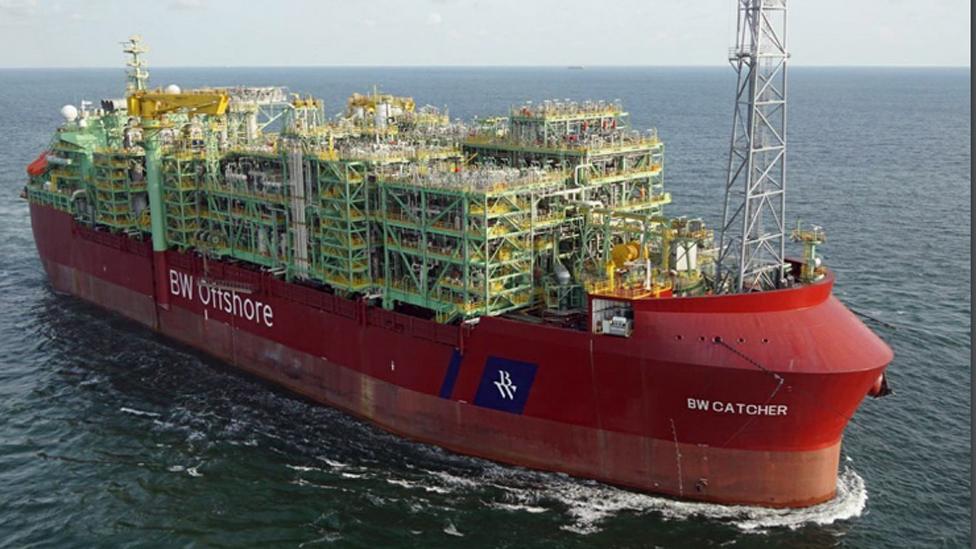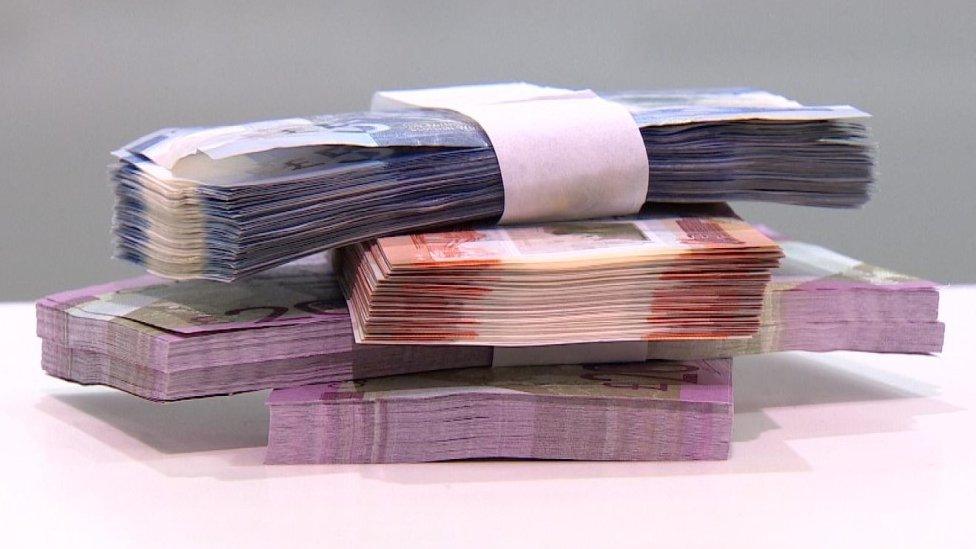Catcher in the Briny
- Published

A Catcher FPSO can carry up to 650,000 barrels of oil
The Catcher area has cost $1.6bn to bring on-stream. That's 29% under its budget when the investment was approved.
Making its announcement on Wednesday morning, Premier Oil wants the first oil, on 23 December, to signal to the market that it is a serious player in getting an offshore field to first oil, and beyond.
It starts with 10,000 barrels a day. Once all 19 wells from various fields in the Catcher area are producing, it should hit the target 60,000 barrels per day some time in 2018.
To put that in context, UK offshore production has been between 1.4m and 1.9m barrels in the past couple of years. World production is over 90m per day.
Happily for Premier Oil, the price of Brent crude oil surged just as it came on-stream, reaching $67 per barrel on very light Christmas trading.
Also happily, for the North Sea industry, this coincided with the Forties Pipeline Network being brought back onstream, after three weeks of repairs forced by a crack found at an underground section in Aberdeenshire.
It's not up to speed yet, while the new owner, Ineos, limits the flow and pressure.
That is estimated to have cost $20m a day in lost production from the 85 fields linked to Forties.
Basin in decline
It wasn't much of a catch for Catcher, however, as it is based on a Floating Production, Storage and Offloading (FPSO) model - a rather large ship that bobs in the North Sea, the length of two football pitches, and holding up to 650,000 barrels of oil.
Once full, a tanker can take its contents to Rotterdam or Grangemouth.
These developments remind us of five key elements to the North Sea oil and gas story at its present stage
1. While the 'basin' is in decline, it's enjoying an uptick because of vast investment in recent years, from which new fields continue to come on-stream.
2. Much of the new investment is from smaller companies, such as Premier. While being the producer, it owns half of the Catcher area, and Cairn Energy, based in Edinburgh, owns a fifth.
3. "Mature" North Sea hardware is vulnerable to expensive outages as it shows signs of wear and tear.
4. The price of oil remains volatile. The past year has seen Brent crude rise by 17%, much of that in the past two months, after sharp falls from later 2014. It was buoyed by the Forties Pipeline shutdown.
It was raised further in the past three days by an explosion in a Libyan pipeline that has set back that country's hopes of re-establishing a reliable supply despite its continued civil war.
5. That 29% saving on the original budget for Catcher is not unique to Premier. Costs have been tumbling in oil production.
So while the price picks itself off the floor of $30, with a steady run through this year in the upper 50s, some oil fields begin to look financially attractive for development. That's certainly true of the onshore fields in the US, where fracking is back.
While OPEC, the cartel of oil exporters, a month ago agreed another phase of production cutbacks, in order to put a floor under the price, the American industry can step in with a quick hit of new, fracked production, thus keeping a ceiling on the price.
Pipeline cracked
In this, the North Sea has some influence. You could see that from the impact of the Forties Pipeline shut-down on the world price.
But not much influence. Beyond the short-term, offshore producers in the North Sea know that they have to accept the price set by forces controlled far away.
What they can control is cost, and more than you might think. An industry survey published earlier this month showed a sharp rise in the extent of collaboration between oil producers, mostly in order to reduce costs.
Deloitte found 95% of respondents see collaboration as being built into their business model.
Success rates were more modest, at 47%, but they're improving a lot as the industry learns, up from 27% in 2015.
As decommissioning efforts are ramped up, around 80% of those involved say collaboration will have to become part of the financial case.
Re-engineered
And if Catcher looks impressive, consider the case of Johan Castberg, a field with reserves of more than 650 million barrels of oil.
It's located to the north of Tromso, off the north of Norway, which has both challenging and controversial elements of Arctic drilling.
The original costing was for 100bn Norwegian kroner (£9bn) and breakeven point at a world oil price of $80 per barrel.
After re-engineering the thinking, and re-thinking the engineering, the design and putting pressure on suppliers' prices, that initial investment was halved, and it can be profitable at below $35 per barrel.
That's why it got approval from the Statoil board earlier this month, to be a major part of its investment in Norwegian waters through to first oil, scheduled for 2022.
Two months ago, Norway's state-controlled driller had an oil find at the Verbier field in the UK sector, and it's investing in drilling off South America.
But it isn't resting on an oily future. At the same time, it's seen a UK offshore wind array opened, invested in solar, and started work on the world's first floating offshore wind array, the Hywind project in the Moray Firth.
On the same theme, nor is Royal Dutch Shell sticking with the knitting. It has just bought First Utility, a British energy retailer, signifying a shift into downstream energy and smart grid technology.
- Published14 December 2017

- Published14 December 2017
